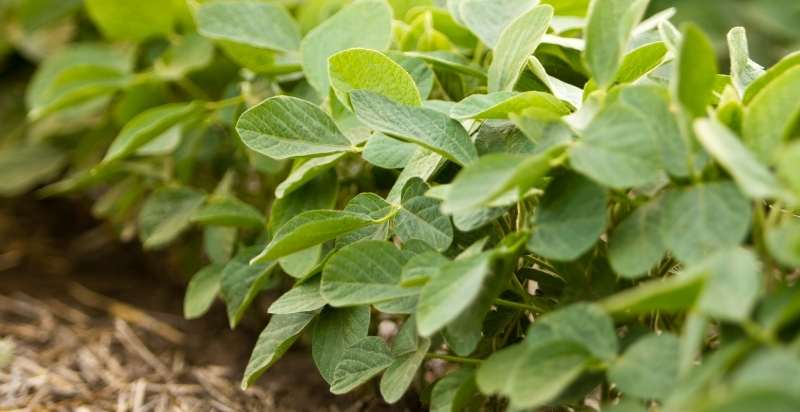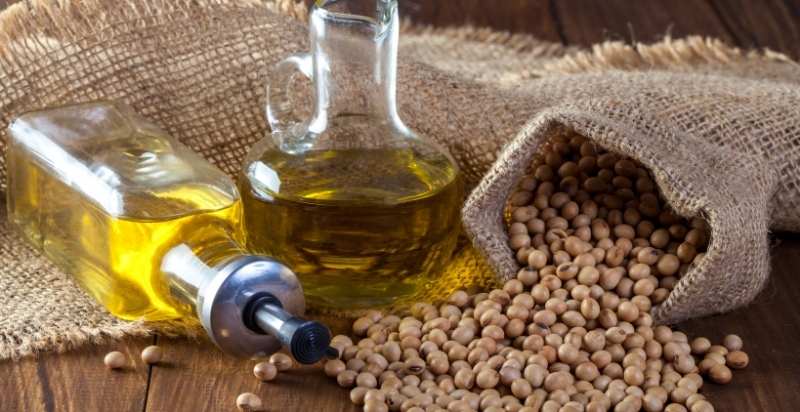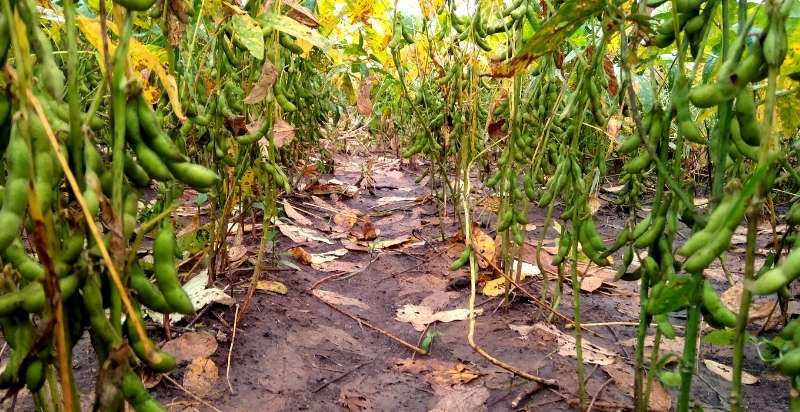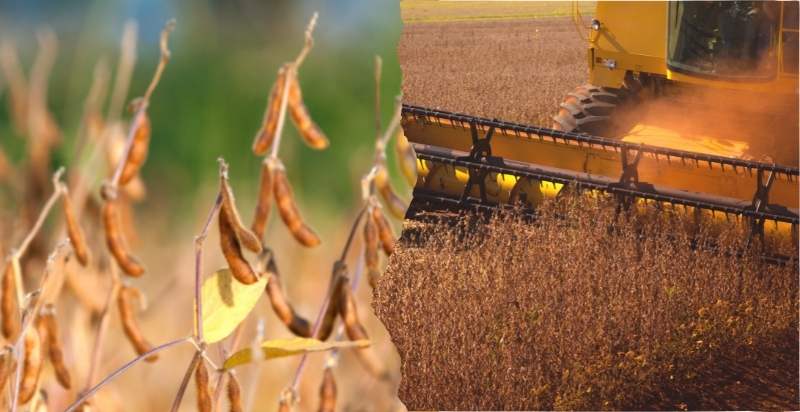The soybean (Glycine max), sometimes known as the soya bean, is an East Asian native legume widely cultivated for its edible bean, which has a variety of purposes. Soybeans have historically been used to make non-fermented foods like tofu and tofu skin, as well as soy milk. Soy sauce, fermented bean paste, natto, and tempeh are foods made from soy.
Today, soybeans are grown worldwide, with the majority of production in the USA, Brazil, Argentina, China, and India. This guide will give you all the details required to grow your soybeans, whether you’re a smallholder farmer or a large-scale commercial operation.
What Is Soybean?
The humble soybean is a legume native to East Asia, widely grown for its edible bean and numerous uses. Due to its high oil content, the plant is classed as an oilseed rather than a pulse by the UN Food & Agriculture Organization (FAO).
Soybeans are thought to have originated in China, where they have been cultivated for over 5,000 years. They were first introduced to the West by explorer Marco Polo in the 13th century and soon became an important crop in Europe and North America. They are now a staple crop in many parts of the world, providing animal feed and a range of food products for human consumption.
| Common Name(s) | Soybean, edamame, soya bean |
| Scientific Name | Glycine max |
| Days to Harvest | 45-65 days for fresh harvest |
| Light | Full sun |
| Water | 1 inch per week |
| Soil | Well-drained |
| Spacing | Single Plants: 5″ (15cm) each way (minimum) Rows: 5″ (15cm) with 5″ (15cm) row gap (minimum) |
| USDA Hardiness Zones | 2 to 11 |
| Fertilizer | Aged compost midsummer |
| Pests | Aphids, Mexican bean beetle |
| Diseases | Fungal and bacterial blight |
Soybean Plants:
Soybean plants are erect, herbaceous, annual plants growing to 60–120 cm (24–47 in). The stems branch occasionally and are covered with fine hairs. Trifoliolate leaves, having three to four leaflets per leaf, are typical of the species; the leaflets are ovate to lanceolate, measuring 6–15 cm (2.4–5.9 in) long and 3–8 cm (1.2–3.1 in) wide. Leaves are alternate on the stem, each having an entire margin.
Flowers of the soybean plant are borne in racemes or short umbels, each flower having five petals – two outer green sepals and three inner yellowish-white petals fused into a bell-shaped corolla. The ovary is sessile and has two locules, each containing two ovules. The flowers are flawless with male and female gametes produced in each flower by the stamen and pistil, respectively.

Origin Of The Soybean:
The soybean is native to China and has been cultivated for over 5,000 years. It probably originated in the Yunnan-Guizhou Plateau region in southwestern China and was first domesticated in the Huang He (Yellow River) valley in the north.
From China, soybeans were introduced into Korea and then into Japan, probably during the Yayoi period (c. 300 BC-AD 300). They reached Europe in the late 17th century and were first planted in North America in 1765 by settlers in Illinois. China and the United States were the top two soybean producers in the world at the beginning of the twenty-first century.
Soybeans are grown in many temperate regions and tropical areas of the world. The major producing countries are the United States, Brazil, Argentina, India, and China. In the United States, soybeans are grown mostly in the Midwest; the main producing states are Illinois, Iowa, Indiana, Minnesota, Nebraska, and Missouri.
In Brazil and Argentina, they are grown extensively in the Paraná Basin of southern Brazil and the Pampas region of Argentina. India is a leading producer in eastern Asia. In China, soybean production is widespread but is particularly intense in the northeast provinces of Heilongjiang, Jilin, and Liaoning.
In addition to the major producing countries, soybeans are grown in many other countries, including Canada, Mexico, Paraguay, Uruguay, Bolivia, Sri Lanka, Myanmar (Burma), Ethiopia, and Kenya.

Nutritional Benefit Soybean:
The soybean is a nutrient-dense food. A 1/2-cup serving of cooked soybeans provides approximately.
- * 9 g of protein
- * 5 g of fat
- * 8 g of carbohydrate
- * 7 g of dietary fiber
- * 2 mg of iron
- * 36 mg of phosphorus
- * 168 mg of calcium
- * 408 mg of potassium
Health Benefits Of Soybeans:
The soybean is a good source of protein, essential amino acids, and vitamins B1, B2, B3, and E. Additionally, they are a good source of iron, phosphorus, and calcium.
Soybeans contain phytoestrogens – plant-derived compounds that mimic the effects of estrogen in the body. They also contain isoflavones, which have some health-promoting effects, including reducing the risk of osteoporosis and relieving menopausal symptoms such as hot flashes.
Eating soybeans or foods made from them may help protect against breast cancer. Soybeans also contain compounds that could help protect against prostate cancer. Eating soy products may help decrease blood pressure, according to some research.
People sometimes worry that the phytoestrogens in soy might increase cancer risk. Population studies, however, have not discovered a higher risk of breast cancer in women who consume soy products. Some studies suggest that soy intake is associated with a reduced risk of breast cancer.
Uses Of Soybeans:
The most important use of soybeans is as a source of oil, and the oil content of the seed is about 18 percent. Soybean oil is used in salad and cooking oils and, after hydrogenation, as shortenings and margarine.
The residue from extracting soybean oil (soybean meal) is an important animal feed. In the United States, about 60 percent of the soybeans grown are used for livestock feed; in Europe, the figure is about 80 percent.
Soybeans are also used to a limited extent in human food. In the United States and Europe, soy flour, grits (cracked kernels), and flakes are used as ingredients in various bakery products, cereals, and pasta.
Textured vegetable protein (TVP) made from soy flour is used as a meat extender and alternative in sausages, burgers, chili, tacos, loaves, and other dishes. Tofu (bean curd), tempeh, nattō, miso (fermented soybean paste), and soy sauce are traditional foods that have become popular in the West. These foods, unlike meat, are low in saturated fat, high in protein, and free of cholesterol.
The soybean plant is also used as a source of industrial materials. Soybean oil manufacturers paint, varnish, resins, inks, and lubricants. The residue from making soybean oil (soybean meal) is used in adhesives, plastics, explosives, carpet backing, and insulation. In addition, the straw can be used for paper pulp and the hulls for animal bedding or fuel.

How To Grow Soybeans:
Soybeans are a relatively easy crop to grow, but there are a few things you need to know before you start. Here is a basic guide to help you get started growing soybeans:
Whether you’re a smallholder farmer or a large-scale commercial operation, so let’s get started :
Site Selection and Preparation
When selecting a site to grow soybeans, Picking a location with well-drained soils and full sun exposure (at least six hours of sunlight per day) is crucial. Avoid areas prone to flooding or excessive moisture, which can lead to disease and root rot problems.
Once you have selected a suitable site, the next step is to prepare the soil for planting. This involves testing the soil’s pH level and adding amendments as needed to bring it within the ideal range of 6.0 to 7.0.
Soybeans prefer neutral to slightly acidic soils. The pH of your soil can be lowered if it is overly alkaline by adding aluminium sulphate or elemental sulphur. You can add limestone or wood ashes to your soil to improve the pH if it is excessively acidic.
It is also important to add organic matter to the soil before planting in the form of compost, manure, or peat moss. Organic matter helps improve drainage and aeration while providing essential nutrients for plant growth.
Planting
Soybeans are typically planted in late spring, after the last frost date for your area. The ideal soil temperature for germination is between 60°F and 85°F. If the soil is too cold, soybeans will not germinate; if it is too hot, they will germinate poorly and suffer stunted growth.
When planting, soybeans should be planted at a depth of 1 to 2 inches. They should be spaced 10 to 14 inches apart in rows 30 to 36 inches apart.
Soybeans can be planted using various methods, including broadcast seeding, drill seeding, and transplanting.
- Broadcast seeding is the simplest and most common method; it simply involves scattering the seeds over the soil surface and then raking them in.
- Drill seeding involves planting the seeds in rows using a seed drill or similar device.
- Transplanting is only necessary if you grow soybeans indoors or in a greenhouse.

Care and Maintenance
Once your soybeans have been planted, they will require regular care and maintenance to ensure optimal growth and yield. This includes watering, fertilizing, weeding, and pest control.
Soybeans are relatively drought-tolerant but must be watered regularly during their early growth stages. Once the plants have reached 6 to 8 inches in height, they can be allowed to dry out slightly between watering. However, supplemental irrigation may be necessary during periods of extended drought to prevent stress and ensure proper plant development.
Fertilization is also important for healthy soybean plants. Soybeans are nitrogen-fixing plants, which means they can convert atmospheric nitrogen into a form that plants can use. However, they still require additional nutrients for optimal growth.
A general-purpose fertilizer can be applied at the rate of 1 pound per 100 square feet of planting area.
Weeding is another important aspect of soybean plant care. Hand-pulling is the best method for removing weeds, as it minimizes the risk of damage to soybean plants.
However, if the weed problem is severe, you may need to use an herbicide. Be sure to select a product that is labeled for use on soybeans and follow all directions carefully.

Pests And Diseases And Their Preventions
Pests and diseases are relatively uncommon in soybeans, but there are a few that you should be aware of. The most common insect pests include aphids, bean beetles, and Japanese, and these can be controlled with various insecticides or by using traps.
The most common disease problems include powdery mildew, rust, and white mold. These can be controlled with fungicides.
To prevent problems with pests and diseases, starting with healthy plants and practicing good crop management techniques is important. This includes proper spacing, adequate ventilation, and timely removal of plant debris. Additionally, crop rotation can help to reduce the incidence of problems by breaking the life cycle of pests and diseases.
Soybeans and corns are good companion plants as both plants help each other by improving pest control and attracting pollinators.
Harvesting
Soybeans are typically ready for harvest 90 to 120 days after planting. The exact time will depend on the variety of soybeans you are growing and the growing conditions. To determine if your soybeans are ready, snap a few open pods. They are ready to harvest if the beans inside are plump and dark green.
Once your soybeans are ready, you can begin harvesting them by hand or with a mechanical harvester. If you are harvesting by hand, cut the stems about 2 inches above the ground and place the plants in a container. If using a mechanical harvester, follow the manufacturer’s instructions carefully to avoid damage to the plants.

How To Eat Soybean?
Soybeans can be eaten whole, sprouted, or cooked. They can also be processed into various food products, such as soy milk, tofu, and tempeh.
To eat whole soybeans, cook them until tender and add them to salads, soups, or stir-fries. You can roast them in the oven for a quick and easy snack. Toss the beans with a bit of oil and your favorite seasonings, and roast at 400 degrees Fahrenheit for 15 minutes.
Sprouting soybeans is another great way to enjoy their nutritional benefits. To do this:
- Soak the beans in water for 8 hours or overnight.
- Drain and rinse them before placing them in a sprouting tray or jar.
- Rinse the beans twice daily and allow them to sprout for 3 to 5 days. Once they have sprouted, you can add them to salads, sandwiches, or soups.
If you want to enjoy cooked soybeans, you can use a few different methods. One option is to stew them in water for 30 minutes, and you can also boil them for 3 minutes and then let them soak in hot water for 30 minutes.
Another very popular option is to pressure cook the beans for 2 minutes. Whichever method you choose, be sure to cook the beans until they are soft and tender.
Once cooked, soybeans can be used in a variety of recipes. They can be mashed and used as a replacement for ground beef in tacos or burgers, and they can also be pureed and added to soups or sauces. Additionally, cooked soybeans can be used to make tofu, tempeh, and other soy-based products.
Soybean Allergies:
Some people may be allergic to soybeans. An allergic reaction to soy may cause hives, difficulty breathing, and swelling of the face, lips, or throat. In severe cases, anaphylaxis can occur.
If you have a soy allergy, it is important to avoid all foods containing soy, including soy milk, tofu, tempeh, edamame, and miso. Additionally, many processed foods contain soy ingredients, so it is important to read labels carefully if you have a soy allergy.
Conclusion
A species of legume originally from East Asia, soybeans are now produced worldwide due to decades of cultivation. In addition to being the main component of many Asian dishes, soybeans are also used to produce various culinary items, including tofu, soy milk, and tempeh.
They can be eaten whole, sprouted, or cooked; they can be ground into flour or milk and used to make biodiesel fuel. No matter how you decide to use them, soybeans are a versatile and nutritious crop that is well worth growing.
- Everything You Wanted to Know About Red Tamarillos - June 2, 2025
- A Guide to Tulips: Everything You Need to Know & More… - June 2, 2025
- Guanabana: Description, Flavor, Benefits, And Uses - May 27, 2025
